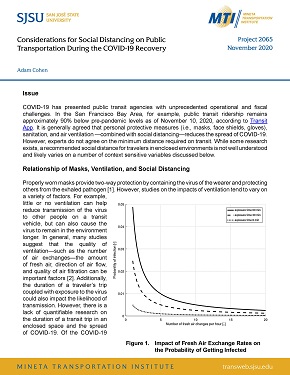- 408-924-7560
- mineta-institute@sjsu.edu
- Donate
Considerations for Social Distancing on Public Transportation During the COVID-19 Recovery
COVID-19 has presented public transit agencies with unprecedented operational and fiscal challenges. In the San Francisco Bay Area, for example, public transit ridership remains approximately 90% below pre-pandemic levels as of November 10, 2020, according to Transit App. It is generally agreed that personal protective measures (i.e., masks, face shields, gloves), sanitation, and air ventilation — combined with social distancing — reduces the spread of COVID-19. However, experts do not agree on the minimum distance required on transit. While some research exists, a recommended social distance for travelers in enclosed environments is not well understood and likely varies on a number of context sensitive variables. This MTI research perspective reviews relevant literature and summarizes key findings. It should be noted that COVID-19 is a rapidly evolving situation. Readers are encouraged to consider this content in conjunction with latest health information and policy guidance.
Adam Cohen
Adam Cohen is a senior researcher with the Mineta Transportation Institute of San Jose State University and the Institute of Transportation Studies at UC Berkeley. His research focuses on innovative mobility strategies, such as shared mobility, mobility on demand, mobility as a service, smart cities, and emerging technologies. He has co-authored numerous publications in peer-reviewed journals and conference proceedings.
-
Contact Us
San José State University One Washington Square, San Jose, CA 95192 Phone: 408-924-7560 Email: mineta-institute@sjsu.edu






